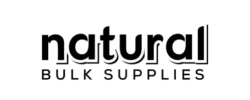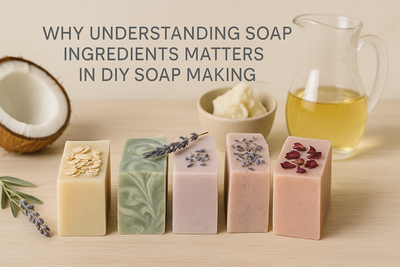Soap Ingredients Guide for DIY Enthusiasts: Everything You Need to Know Before You Start
Posted by Natural Bulk Supplies on on Sep 11th 2025
Why Understanding Soap Ingredients Matters in DIY Soap Making
Cold process soap making is one of the most loved crafts for beginners and small business makers. It is science and art coming together. Oils, butters, lye, water, and extras all change how a bar feels, lathers, and lasts. By understanding what soap ingredients do, you can create bars that are gentle, bubbly, long lasting, or luxurious. This is why many DIY soap makers say the first step is to learn the role of ingredients before following recipes.
Natural Bulk Supplies offers cosmetic grade USA soap supplies so that you have safe and reliable materials for every batch.
Base Oils and Butters: The Building Blocks of Soap
Soap recipes use a mix of hard and soft oils to create balance.
- Coconut Oil: A staple in soap ingredients. Makes bars hard and gives bubbly lather. Too much can feel drying, so balance it with other oils.
- Olive Oil: Classic choice for mild and conditioning soap. Produces creamy lather that gets better with curing.
- Palm Oil, Lard, or Tallow: Add firmness and stable lather so the soap lasts longer.
- Shea Butter or Cocoa Butter: Bring creaminess and a luxury feel. Help bars harden over time.
- Castor Oil: Used in small amounts to stabilize lather and help fragrance stick.
A beginner soap recipe usually combines three to five of these oils for a balanced bar.
Lye: The Essential Ingredient for Saponification
What is lye in soap making
Lye, also called sodium hydroxide, is the ingredient that transforms oils into soap through a chemical reaction called saponification. Without lye there is no real soap.
Beginners often ask if lye is still in soap after it cures. The answer is no. During the cure, lye reacts completely with oils and creates soap and natural glycerin. That is why cured soap is safe and gentle to use.
Always use safety gear when handling lye. Wear gloves and goggles. Add lye into liquid slowly, never the other way around. Measure everything with a digital scale for accuracy.
Liquid Bases for Soap Making
The most common liquid base in cold process soap is distilled water. It mixes cleanly with lye and gives consistent results.
Once you are confident, you can try alternatives:
- Goat milk for creamy bars
- Aloe juice for soothing properties
- Herbal teas for natural color and subtle scent
Beginners should always start with distilled water to learn the basics.
Natural soap ingredients make your bars unique and beautiful.
- Clays such as kaolin or rose clay give soft colors and a silky feel
- Activated charcoal creates a rich black bar with purifying qualities
- Ground oatmeal adds gentle exfoliation and soothing skin benefits
- Botanicals like dried herbs and petals add natural beauty when sprinkled on top
Simple additives like sugar, salt, or sodium lactate can also help boost lather, harden bars, or make unmolding easier.
Fragrance: Essential Oils vs. Fragrance Oils
Scent is one of the most searched questions in DIY soap making. Many ask, what are the best essential oils for soap?
- Essential oils come from plants. Lavender, peppermint, citrus, and tea tree are popular choices. They are natural but may fade faster.
- Fragrance oils are made for soapmaking. They last longer and offer endless blends you cannot find in nature, such as vanilla sugar or ocean breeze.
Both can be safe when used at proper levels. Beginners should always test small batches first.
Tools, Calculators, and Equipment Every Soap Maker Needs
Soap making works best when you are prepared. You will need:
- A digital scale for measuring oils and lye
- Stick blender for mixing to trace
- Heat safe containers and pitchers
- Silicone or wooden molds
- Goggles and gloves for safety
One of the most important tools is a soap calculator. It checks that your oils and lye are balanced and that your recipe is safe. Beginners should always run every recipe through a calculator, even ones found online.
Safety and Creativity Tips for Soap Makers
- Measure by weight, not volume
- Write down every recipe so you can repeat your success
- Start simple with one color and one fragrance
- Watch trace carefully. Thin trace is good for smooth soap. Thick trace is better for textured tops
- Cure bars for four to six weeks so they harden, last longer, and feel gentle on skin
Common Questions Beginners Ask About Cold Process Soap Making
What are the best oils for beginner soap recipes?
A mix of olive oil, coconut oil, and palm oil or lard is a simple, reliable choice.
Do I need lye to make soap?
Yes. Without lye there is no true soap. Melt and pour bases already contain lye that has reacted, but cold process requires you to handle it yourself.
How long should soap cure?
Cold process soap should cure for at least four to six weeks in a dry, cool space with good air flow.
Why did my soap crack or separate
This can happen if temperatures are too high or the recipe is unbalanced. Keeping oils and lye close in temperature helps prevent it.
Final Thoughts: Craft Soap That’s Truly Yours
Cold process soapmaking is more than just a recipe. It is learning how each ingredient changes the final bar. With the right oils, lye, liquids, additives, and scent, you can create soap that is safe, personal, and beautiful.
By using high-quality natural soap ingredients from Natural Bulk Supplies and checking every recipe with a soap calculator, you can trust that each batch will be successful. Whether you are new to DIY soap making or planning to start a small soap business, this guide gives you the foundation to craft bars that are uniquely yours.
Ready to create?
- Browse the full fragrances collection.
- Check out our butters range to elevate texture and moisture.
- Dive into the blog for DIY guidance.

